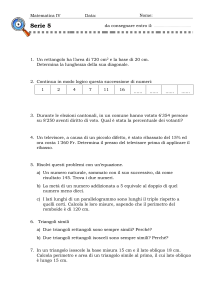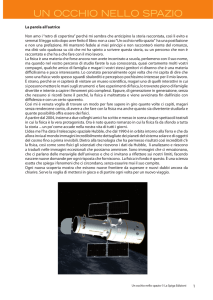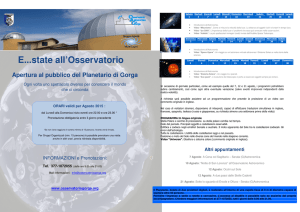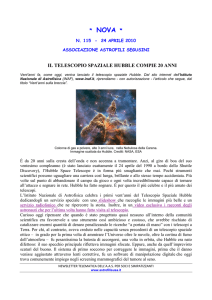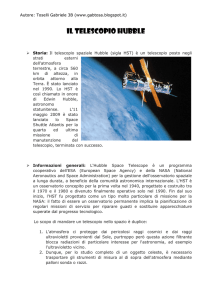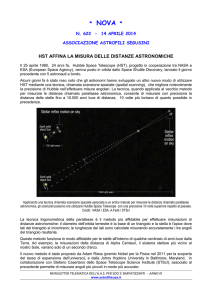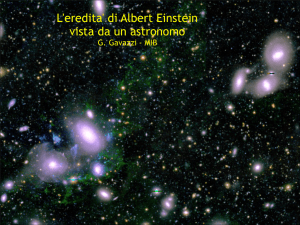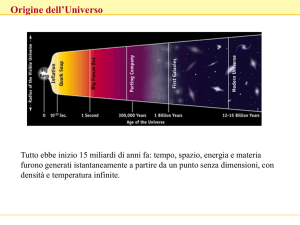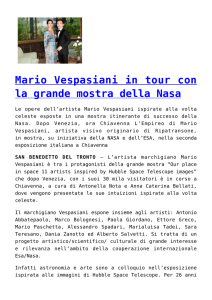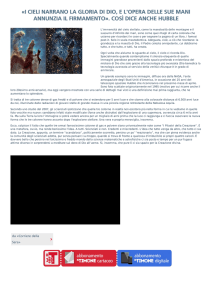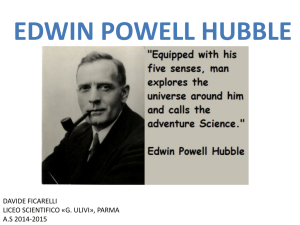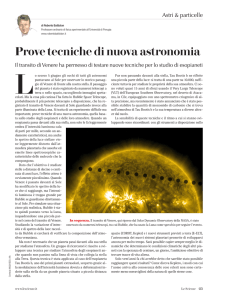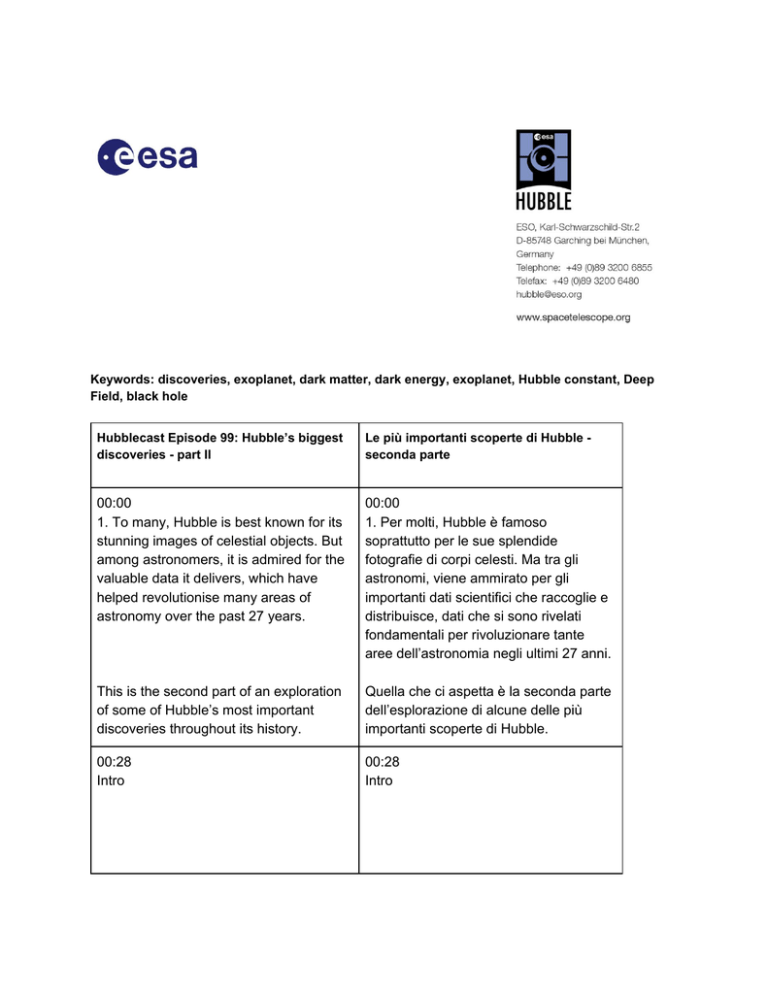
Keywords: discoveries, exoplanet, dark matter, dark energy, exoplanet, Hubble constant, Deep
Field, black hole
Hubblecast Episode 99: Hubble’s biggest
discoveries - part II
Le più importanti scoperte di Hubble seconda parte
00:00
1. To many, Hubble is best known for its
stunning images of celestial objects. But
among astronomers, it is admired for the
valuable data it delivers, which have
helped revolutionise many areas of
astronomy over the past 27 years.
00:00
1. Per molti, Hubble è famoso
soprattutto per le sue splendide
fotografie di corpi celesti. Ma tra gli
astronomi, viene ammirato per gli
importanti dati scientifici che raccoglie e
distribuisce, dati che si sono rivelati
fondamentali per rivoluzionare tante
aree dell’astronomia negli ultimi 27 anni.
This is the second part of an exploration
of some of Hubble’s most important
discoveries throughout its history.
Quella che ci aspetta è la seconda parte
dell’esplorazione di alcune delle più
importanti scoperte di Hubble.
00:28
Intro
00:28
Intro
00:39
[Narrator]
In the first episode we saw how Hubble
had explored the early Universe,
calculated its age and helped in the
search for the elusive dark energy.
00:39
[Narrator]
Nella prima parte abbiamo visto come
Hubble abbia esplorato l’Universo
giovane, calcolato la sua età e aiutato
nella ricerca sull’elusiva energia oscura.
Dark energy, however, was not the only
invisible thing Hubble helped to reveal.
The telescope carried out a survey to
study a huge swathe of the night sky,
searching for clues about the equally
mysterious — but unrelated — dark
matter.
Ma l’energia oscura non è l’unica cosa
invisibile che Hubble ha contribuito a
rivelare... Il telescopio ha condotto
un’indagine estesa per analizzare una
enorme porzione di spazio, alla ricerca
di indizi sulla materia oscura, misteriosa
tanto quanto l’omonima energia, ma non
connessa ad essa.
Astronomers used Hubble to create a
map of everyday, visible matter, from
which they could trace the large-scale
distribution of dark matter by studying
how its gravitational presence distorted
light in the images.
Gli astronomi hanno sfruttato Hubble per
comporre una mappa della materia
ordinaria, visibile, dalla quale poter
tracciare la distribuzione su larga scala
della materia oscura studiando come la
sua presenza gravitazionale distorceva
la luce nelle immagini.
Maps like these are a key step in
understanding this mysterious
component of the Universe.
Mappe come questa sono fondamentali
nella comprensione di questa misteriosa
componente dell’Universo.
01:39
[Narrator]
7. While dark matter is still a mystery,
Hubble lifted the veil surrounding the
cosmic monsters that lurk at the centre of
most galaxies: supermassive black holes.
01:39
[Narrator]
7. Anche se la materia oscura rimane un
mistero, Hubble ha sollevato il velo che
ricopriva i mostri cosmici nascosti al
centro di moltissime galassie: i buchi
neri supermassivi.
Using its spectroscopic observing
capabilities, Hubble peered into the
galaxy cores and found that the stars
there moved in tight orbits at enormous
velocities. This strange behaviour
indicated the presence of a truly colossal
gravitational field — produced by a
supermassive black hole. This was the
first solid proof of their existence!
Sfruttando le sue capacità
spettroscopiche, Hubble ha sbirciato nel
cuore delle galassie e ha trovato che lì le
stelle si muovono lungo orbite
strettissime a velocità enormi. Questo
strambo comportamento ha indicato la
presenza di un campo gravitazionale
davvero colossale, prodotto da un buco
nero supermassivo. Questa
osservazione fu la prima prova chiara
della loro esistenza!
Today it is known that black holes are
located in the centres of almost all
galaxies. Some of them are very active,
consuming gas from their surroundings
— and even whole stars!
Oggi è noto che ci sono buchi neri al
centro di pressoché ogni galassia. Alcuni
di essi sono parecchio attivi, in grado di
consumare il gas contenuto nelle
vicinanze, e a volte ingurgitare intere
stelle!
02:40
[Narrator]
8. In 2008, Hubble made something else
visible for the first time. While studying
the bright star Fomalhaut, the telescope
discovered a tiny point of light in the
extensive dusty ring surrounding it.
Hubble turned its attention to planet
hunting, taking the first direct visible-light
image of a planet in another star system.
02:40
[Narrator]
8. Nel 2008, Hubble ha reso per la prima
volta visibile qualcos’altro… mentre
studiava la stella brillante Fomalhaut, il
telescopio ha scoperto un piccolissimo
puntino luminoso nel vasto anello di
polveri che la circonda. Hubble si è così
concentrato sulla caccia agli esopianeti,
riuscendo a produrre la prima immagine
diretta in luce visibile di un pianeta di un
altro sistema stellare.
While not one of its original science
goals, Hubble has since made a name for
itself as an exoplanet explorer — in
particular studying exoplanet
atmospheres.
Sebbene all’inizio ciò non facesse parte
dei suoi obiettivi, da quel momento
Hubble si è fatto un nome anche come
esploratore di esopianeti, e in particolare
per lo studio delle loro atmosfere.
The chemical makeup of a planet’s
atmosphere leaves a unique fingerprint
on the starlight that passes through it. In
this way, Hubble analysed for the first
time the atmosphere of a super-Earth, 40
light-years away. And in the future,
Hubble could possibly find hints of life in
one of these fingerprints.
La composizione chimica dell’atmosfera
di un pianeta lascia un’impronta unica
nella luce della stella che la attraversa.
In questo modo, Hubble ha potuto
analizzare per la prima volta l’atmosfera
di una super-Terra, a 40 anni luce di
distanza. E in futuro, potrebbe anche
trovare segni di vita in una di queste
impronte.
03:50
[Narrator]
9. Beyond discovering and imaging
exoplanets, Hubble has also
revolutionised our overall understanding
of planet formation.
03:50
[Narrator]
9. Oltre a scoprire e a fotografare
esopianeti, Hubble ha anche
rivoluzionato la nostra comprensione
generale sulla formazione dei pianeti.
Studying the Orion Nebula, Hubble made
the stunning discovery that at least half of
the stars in the region were surrounded
by vast discs of rotating gas and dust —
the raw materials necessary for the
formation of planets.
Studiando la nebulosa di Orione, Hubble
ha fatto l’incredibile scoperta che almeno
la metà delle stelle di quella regione
sono circondate da ampi dischi di polveri
e gas in rotazione, materiale primario
necessario alla formazione di pianeti.
Prior to Hubble’s work, just one planetary
system had ever been confirmed.
Hubble’s observations showed that
planets are being formed around many
more stars than previously thought,
increasing the possibility that life could
exist somewhere out there.
Prima del lavoro di Hubble, era stata
confermata solo l’esistenza di un
sistema planetario. Le sue osservazioni
hanno mostrato che i pianeti vengono
formati attorno a molte più stelle di
quanto si pensasse, e dunque con una
maggiore possibilità che la vita possa
esistere anche altrove.
04:41
[Narrator]
Alongside planet formation, Hubble has
always been interested in the birth, life
and death of their parent stars.
04:41
[Narrator]
Oltre alla formazione dei pianeti, Hubble
è sempre stato interessato alla nascita,
vita e morte delle loro stelle madri.
Hubble’s high resolving power has been
crucial in the investigation of star
formation regions, both in the Milky Way
and in other galaxies; and its infrared
capabilities have allowed it to peer
through the thick clouds of dust and gas
present in these regions.
L’alto potere risolutivo di Hubble è stato
cruciale per investigare le regioni di
formazione stellare, nella Via Lattea e in
altre galassie; e le sue capacità
nell’infrarosso hanno permesso di
sbirciare attraverso le spesse nubi di
polveri e gas di quelle regioni.
The death of a star can be as beautiful
and interesting as its birth. Hubble has
observed both Sun-like stars as they
come to the end of their lives in the form
of planetary nebulae, and massive stars
experiencing explosive deaths as
supernovae.
La morte di una stella è un processo
affascinante tanto quanto la sua nascita.
Hubble ha osservato sia stelle simili al
Sole avvicinarsi alla loro fine sotto forma
di nebulose planetarie, sia stelle più
massicce che invece concludono il
proprio ciclo esplodendo come
supernovae.
By studying them at different times in
their lives, Hubble has allowed us to paint
a more complete picture of stars, the
building blocks of galaxies.
Studiando questi oggetti a tempi
differenti, Hubble ci ha permesso di
tracciare un affresco più completo delle
stelle, mattoncini fondanti delle galassie.
05:57
[Narrator]
10. Throughout the last 27 years, Hubble
— and nature itself — have continued to
surprise us beyond our wildest
imaginations. And there is no doubt that
they will continue to do so in the future.
05:57
[Narrator]
10. Nell’arco degli ultimi 27 anni, Hubble,
e la stessa Natura, ci hanno sorpreso al
di là delle nostre aspettative più
scatenate. E non c’è alcun dubbio che
continueranno a farlo anche in futuro.
Ends xx:xx

